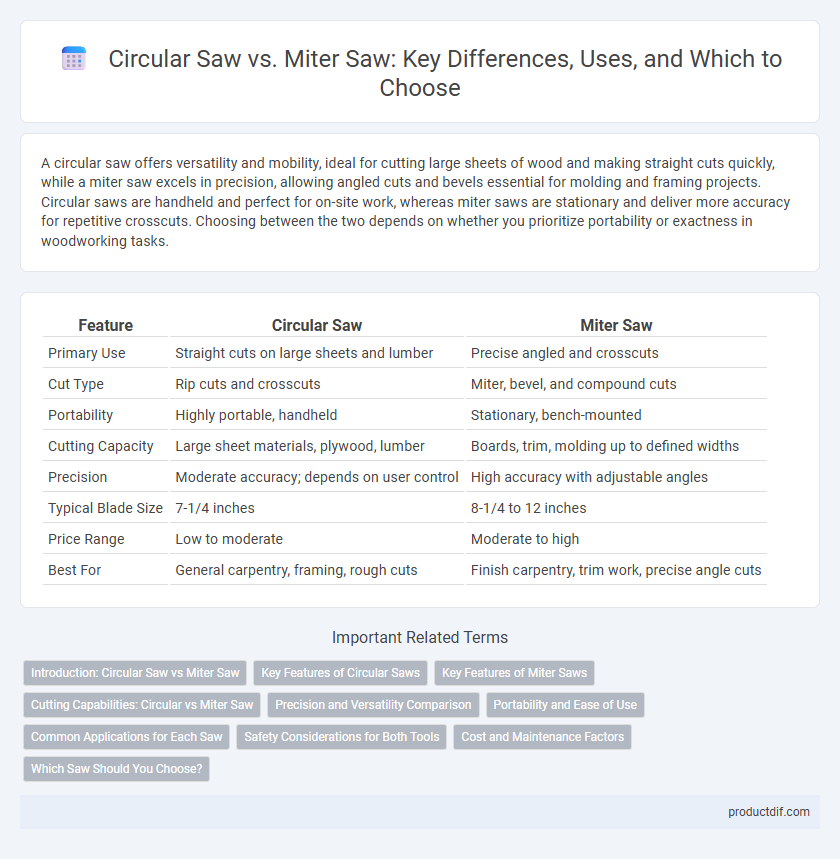A circular saw offers versatility and mobility, ideal for cutting large sheets of wood and making straight cuts quickly, while a miter saw excels in precision, allowing angled cuts and bevels essential for molding and framing projects. Circular saws are handheld and perfect for on-site work, whereas miter saws are stationary and deliver more accuracy for repetitive crosscuts. Choosing between the two depends on whether you prioritize portability or exactness in woodworking tasks.
Table of Comparison
| Feature | Circular Saw | Miter Saw |
|---|---|---|
| Primary Use | Straight cuts on large sheets and lumber | Precise angled and crosscuts |
| Cut Type | Rip cuts and crosscuts | Miter, bevel, and compound cuts |
| Portability | Highly portable, handheld | Stationary, bench-mounted |
| Cutting Capacity | Large sheet materials, plywood, lumber | Boards, trim, molding up to defined widths |
| Precision | Moderate accuracy; depends on user control | High accuracy with adjustable angles |
| Typical Blade Size | 7-1/4 inches | 8-1/4 to 12 inches |
| Price Range | Low to moderate | Moderate to high |
| Best For | General carpentry, framing, rough cuts | Finish carpentry, trim work, precise angle cuts |
Introduction: Circular Saw vs Miter Saw
Circular saws offer versatile, handheld operation for straight and angled cuts on various materials, making them ideal for general-purpose woodworking and construction tasks. Miter saws feature a fixed base and a rotating blade designed for precise crosscuts and angled cuts, commonly used in trim work and framing. Understanding the differences in mobility, accuracy, and cutting capacity helps users select the right saw for their specific project needs.
Key Features of Circular Saws
Circular saws feature a versatile, handheld design that excels in making straight, long cuts on various materials such as wood, metal, and plastic. Equipped with an adjustable depth and bevel angle, circular saws provide precision for flush cuts and angled slicing. Their powerful motors typically range from 10 to 15 amps, delivering high RPMs for efficient cutting in construction and woodworking tasks.
Key Features of Miter Saws
Miter saws feature a pivoting arm that allows for precise angled cuts, making them ideal for molding, trim work, and framing. They typically include adjustable bevel settings and laser guides for enhanced accuracy in crosscuts and compound cuts. High-powered motors and quick blade changes optimize efficiency and versatility for woodworking projects.
Cutting Capabilities: Circular vs Miter Saw
Circular saws provide versatile cutting capabilities with the ability to make straight, rip, and crosscuts on a variety of materials, including plywood and lumber. Miter saws specialize in precise angled cuts, bevels, and compound cuts, offering superior accuracy for molding, trim, and framing projects. The circular saw excels in portability and cutting larger sheets, while the miter saw delivers consistent, repeatable cuts ideal for detailed woodworking tasks.
Precision and Versatility Comparison
Circular saws offer greater versatility for cutting various materials and shapes, making them ideal for rough, straight cuts on large workpieces. Miter saws excel in precision, delivering accurate angled, bevel, and crosscuts with adjustable fences and laser guides for fine woodworking and framing tasks. For projects demanding high accuracy and repeatable cuts, miter saws provide superior control, while circular saws remain flexible for quick, diverse cutting needs.
Portability and Ease of Use
A circular saw offers superior portability due to its lightweight design and handheld operation, ideal for on-the-go cuts and outdoor projects. Miter saws, while typically heavier and stationarily mounted, provide precise angled cuts but require a fixed workspace. Users seeking easy maneuverability and quick setup favor circular saws, whereas those prioritizing accuracy and repeatability lean towards miter saws despite reduced portability.
Common Applications for Each Saw
Circular saws excel in making long, straight cuts in various materials such as plywood, lumber, and sheet metal, making them ideal for framing, ripping, and rough carpentry work. Miter saws provide precise crosscuts and angled cuts, commonly used for molding, trim work, and framing tasks requiring accuracy in bevels and miters. Both tools complement each other on construction sites, with the circular saw handling versatile cutting needs and the miter saw delivering fine, angled finish cuts.
Safety Considerations for Both Tools
Circular saws require secure blade guards and stable work surfaces to prevent kickback and accidental contact, while miter saws rely on firm clamping of materials and proper alignment to avoid binding and blade pinch. Both tools demand the use of safety goggles, hearing protection, and maintaining hands clear of the cutting path to reduce injury risks. Regular blade maintenance and awareness of kickback zones further enhance operator safety during cutting tasks.
Cost and Maintenance Factors
Circular saws generally have a lower upfront cost compared to miter saws, making them more budget-friendly for basic cutting tasks. Maintenance for circular saws involves regular blade sharpening and motor dusting, whereas miter saws require more precise calibration and alignment to maintain cutting accuracy. Replacement parts for miter saws tend to be more expensive due to their complex mechanisms, impacting long-term maintenance costs.
Which Saw Should You Choose?
Choosing between a circular saw and a miter saw depends on your project requirements; circular saws offer portability and versatility for cutting large sheets and making straight cuts, while miter saws provide precision for angle cuts and repetitive crosscuts. For framing, roofing, or general construction, a circular saw is ideal due to its ability to handle diverse materials and cutting angles. If your work involves detailed trim, molding, or precise bevel cuts, a miter saw delivers accuracy and efficiency for professional results.
Circular Saw vs Miter Saw Infographic

 productdif.com
productdif.com